Showing Spotlights 417 - 424 of 639 in category All (newest first):
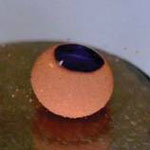 In contrast with microchannel-based fluidics, the manipulation of discrete droplets without using microfluidic channels is a new field. Here, a liquid droplet is not confined to a closed channel and there is no risk of being adsorbed on a channel wall. A liquid marble, a liquid encapsulated by non-wetting powder, could be a new microfluidic device, which is especially useful for handling single liquid droplet. One of the challenges for using liquid marbles as microfluidic devices is the communication between the liquid droplet and the external devices/materials. Researchers in Australia have been trying to develop 'field-responsive smart liquid marbles' which can be opened and closed reversibly on demand, such that the liquid in the marble can be easily taken and other liquid can also be added into the marble easily. The mechanically robust magnetic liquid marble, prepared by coating a water droplet with highly hydrophobic magnetite nanoparticles, can be actuated magnetically.
In contrast with microchannel-based fluidics, the manipulation of discrete droplets without using microfluidic channels is a new field. Here, a liquid droplet is not confined to a closed channel and there is no risk of being adsorbed on a channel wall. A liquid marble, a liquid encapsulated by non-wetting powder, could be a new microfluidic device, which is especially useful for handling single liquid droplet. One of the challenges for using liquid marbles as microfluidic devices is the communication between the liquid droplet and the external devices/materials. Researchers in Australia have been trying to develop 'field-responsive smart liquid marbles' which can be opened and closed reversibly on demand, such that the liquid in the marble can be easily taken and other liquid can also be added into the marble easily. The mechanically robust magnetic liquid marble, prepared by coating a water droplet with highly hydrophobic magnetite nanoparticles, can be actuated magnetically.
Feb 10th, 2010
 Bismuth telluride and its alloys are unique materials. They are the best thermoelectric materials known today, and they are as important to the thermoelectric industry - for cooling and energy generation applications - as silicon is important to the electronic industry. It has been predicted theoretically that structuring bismuth telluride into crystalline ultra-thin films (with the thickness of few nanometers) would lead to a drastic improvement of the thermoelectric figure of merit, which defines the efficiency of the thermoelectric energy conversion. The improvement comes as a result of the strong quantum confinement of charge carriers and reduction of the thermal conductivity. In addition to their thermoelectric applications, bismuth telluride thin films recently attracted attention as promising topological insulators - a newly discovered class of materials with unusual properties. Researchers have now succeeded in 'graphene-inspired' mechanical exfoliation of atomically-thin crystals of bismuth telluride.
Bismuth telluride and its alloys are unique materials. They are the best thermoelectric materials known today, and they are as important to the thermoelectric industry - for cooling and energy generation applications - as silicon is important to the electronic industry. It has been predicted theoretically that structuring bismuth telluride into crystalline ultra-thin films (with the thickness of few nanometers) would lead to a drastic improvement of the thermoelectric figure of merit, which defines the efficiency of the thermoelectric energy conversion. The improvement comes as a result of the strong quantum confinement of charge carriers and reduction of the thermal conductivity. In addition to their thermoelectric applications, bismuth telluride thin films recently attracted attention as promising topological insulators - a newly discovered class of materials with unusual properties. Researchers have now succeeded in 'graphene-inspired' mechanical exfoliation of atomically-thin crystals of bismuth telluride.
Feb 5th, 2010
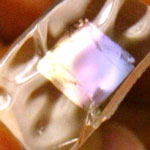 Materials that can produce electricity are at the core of piezoelectric research and the vision of self-powering machines and devices. Nanotechnology researchers are even pursuing nanopiezotronics devices that have the potential of converting biological mechanical energy, acoustic/ultrasonic vibration energy, and biofluid hydraulic energy into electricity, demonstrating a new pathway for self-powering of wireless nanodevices and nanosystems. In addition to miniaturizing piezoelectric devices down to the nanoscale, nanotechnology is also contributing to making next-generation devices more effective. Piezoelectric ceramics for instance generate electrical charge or voltage when they experience stress/strain, and thus are highly efficient at converting mechanical energy into electrical energy. However, ceramics are rigid, which greatly limits the applicability of the energy harvesting. Researchers have now demonstrated that high performance piezoelectric ceramics can be transferred in a scalable process onto rubber or plastic, rendering them flexible without any sacrifice in energy conversion efficiency.
Materials that can produce electricity are at the core of piezoelectric research and the vision of self-powering machines and devices. Nanotechnology researchers are even pursuing nanopiezotronics devices that have the potential of converting biological mechanical energy, acoustic/ultrasonic vibration energy, and biofluid hydraulic energy into electricity, demonstrating a new pathway for self-powering of wireless nanodevices and nanosystems. In addition to miniaturizing piezoelectric devices down to the nanoscale, nanotechnology is also contributing to making next-generation devices more effective. Piezoelectric ceramics for instance generate electrical charge or voltage when they experience stress/strain, and thus are highly efficient at converting mechanical energy into electrical energy. However, ceramics are rigid, which greatly limits the applicability of the energy harvesting. Researchers have now demonstrated that high performance piezoelectric ceramics can be transferred in a scalable process onto rubber or plastic, rendering them flexible without any sacrifice in energy conversion efficiency.
Feb 3rd, 2010
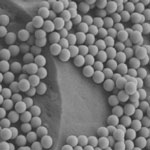 One important aspect of clothing comfort is thermo-physiological comfort. By adjusting the transport of heat and moisture through a fabric, thermo-physiological comfort can keep people comfortable with regard to temperature and moisture. Some hydrophobic fabrics have deficiencies in this area. Take wool. Wool is one of the best insulating fibers known to man - while at the same time being light and soft. The quality that distinguishes wool fibers is the presence of a fatty, water-repellent outer layer that surrounds each fiber. Therefore, the water absorption and sweat venting properties of wool fiber are not very good, which affects the wearing comfort of wool textiles. The wool hydrophobic surface layer is also a barrier to anticrease finishing, dyeing, and grafting of hydrophilic agents, which is an issue in trying to add smart functionalities to wool fabrics.
Researchers have now developed a simple method for fabricating environmentally stable superhydrophilic wool fabrics. They applied silica sols to natural wool fibers to form an ultrathin layer on the surface of the fibers.
One important aspect of clothing comfort is thermo-physiological comfort. By adjusting the transport of heat and moisture through a fabric, thermo-physiological comfort can keep people comfortable with regard to temperature and moisture. Some hydrophobic fabrics have deficiencies in this area. Take wool. Wool is one of the best insulating fibers known to man - while at the same time being light and soft. The quality that distinguishes wool fibers is the presence of a fatty, water-repellent outer layer that surrounds each fiber. Therefore, the water absorption and sweat venting properties of wool fiber are not very good, which affects the wearing comfort of wool textiles. The wool hydrophobic surface layer is also a barrier to anticrease finishing, dyeing, and grafting of hydrophilic agents, which is an issue in trying to add smart functionalities to wool fabrics.
Researchers have now developed a simple method for fabricating environmentally stable superhydrophilic wool fabrics. They applied silica sols to natural wool fibers to form an ultrathin layer on the surface of the fibers.
Jan 15th, 2010
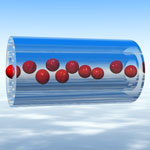 In many biomedical applications, protein nanotubes present several advantages over nanospheres. The layer-by-layer (LbL) deposition technique for the preparation of protein nanotubes has attracted considerable attention because of their potential nanotechnology applications in enzymatic nanocatalysts, bioseparation nanofilters, and targeting nanocarriers. A drawback is that in template synthesis the extraction process often results in physical deformation of the nanotubes. Researchers in Japan have now developed a new procedure using specific solvent and freeze-drying technique. They describe for the first time molecular capturing properties of protein nanotubes with a controllable affinity and size selectivity.
In many biomedical applications, protein nanotubes present several advantages over nanospheres. The layer-by-layer (LbL) deposition technique for the preparation of protein nanotubes has attracted considerable attention because of their potential nanotechnology applications in enzymatic nanocatalysts, bioseparation nanofilters, and targeting nanocarriers. A drawback is that in template synthesis the extraction process often results in physical deformation of the nanotubes. Researchers in Japan have now developed a new procedure using specific solvent and freeze-drying technique. They describe for the first time molecular capturing properties of protein nanotubes with a controllable affinity and size selectivity.
Jan 11th, 2010
 Ultrathin nanosieves with a thickness smaller than the size of the pores are especially advantageous for applications in materials separation since they result in an increase of flow across the nanosieve. Separation of complex biological fluids can particularly benefit from novel, chemically functionalized nanosieves, since many bioanalytical problems in proteomics or medical diagnostics cannot be solved with conventional separation technologies. Researchers in Germany have now fabricated chemically functionalized nanosieves with a thickness of only 1 nm - the thinnest free-standing nanosieve membranes that have been reported so far. The size of the nanoholes in the membranes can be flexibly adjusted down to 30 nm by choosing appropriate conditions for lithography.
Ultrathin nanosieves with a thickness smaller than the size of the pores are especially advantageous for applications in materials separation since they result in an increase of flow across the nanosieve. Separation of complex biological fluids can particularly benefit from novel, chemically functionalized nanosieves, since many bioanalytical problems in proteomics or medical diagnostics cannot be solved with conventional separation technologies. Researchers in Germany have now fabricated chemically functionalized nanosieves with a thickness of only 1 nm - the thinnest free-standing nanosieve membranes that have been reported so far. The size of the nanoholes in the membranes can be flexibly adjusted down to 30 nm by choosing appropriate conditions for lithography.
Dec 9th, 2009
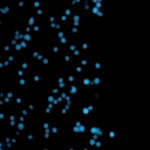 Metastasis is caused by marauding tumor cells that break off from the primary tumor site and ride in the bloodstream to set up colonies in other parts of the body. These breakaway cancer cells in the peripheral blood are known as circulating tumor cells (CTCs). Detecting and analyzing these cells can provide critical information for managing the spread of cancer and monitoring the effectiveness of therapies. Nanotechnology researchers have now developed a an efficient cell-capture platform based on 3D nanostructured substrates. The device is engineered out of nanoscale silicon pillars and has managed to capture up to 65 percent of circulating tumor cells in lab samples within human blood - far more than any existing diagnosis tool for CTC capture.
Metastasis is caused by marauding tumor cells that break off from the primary tumor site and ride in the bloodstream to set up colonies in other parts of the body. These breakaway cancer cells in the peripheral blood are known as circulating tumor cells (CTCs). Detecting and analyzing these cells can provide critical information for managing the spread of cancer and monitoring the effectiveness of therapies. Nanotechnology researchers have now developed a an efficient cell-capture platform based on 3D nanostructured substrates. The device is engineered out of nanoscale silicon pillars and has managed to capture up to 65 percent of circulating tumor cells in lab samples within human blood - far more than any existing diagnosis tool for CTC capture.
Nov 30th, 2009
 Spider silk is a fascinating biopolymer that is stronger than steel and more elastic than rubber. Most of the world's 40,000 species of spiders produce a silken thread that possesses a unique combination of mechanical properties: strength (its tensile strength is about five times as strong a steel of the same density), extensibility (up to 30%) and toughness (its ability to absorb a large amount of energy without breaking). Researchers are experimenting with spider silk to design better adhesives; advanced materials that are both stretchy and strong; and to get clues for protein engineering. Yet the impressive performance of spider silk is not limited solely to tensile mechanics. Researchers have now shown that silk also exhibits powerful cyclic contractions that are precisely controlled by changes in humidity, allowing it to act as a high performance mimic of biological muscles.
Spider silk is a fascinating biopolymer that is stronger than steel and more elastic than rubber. Most of the world's 40,000 species of spiders produce a silken thread that possesses a unique combination of mechanical properties: strength (its tensile strength is about five times as strong a steel of the same density), extensibility (up to 30%) and toughness (its ability to absorb a large amount of energy without breaking). Researchers are experimenting with spider silk to design better adhesives; advanced materials that are both stretchy and strong; and to get clues for protein engineering. Yet the impressive performance of spider silk is not limited solely to tensile mechanics. Researchers have now shown that silk also exhibits powerful cyclic contractions that are precisely controlled by changes in humidity, allowing it to act as a high performance mimic of biological muscles.
Oct 14th, 2009
 In contrast with microchannel-based fluidics, the manipulation of discrete droplets without using microfluidic channels is a new field. Here, a liquid droplet is not confined to a closed channel and there is no risk of being adsorbed on a channel wall. A liquid marble, a liquid encapsulated by non-wetting powder, could be a new microfluidic device, which is especially useful for handling single liquid droplet. One of the challenges for using liquid marbles as microfluidic devices is the communication between the liquid droplet and the external devices/materials. Researchers in Australia have been trying to develop 'field-responsive smart liquid marbles' which can be opened and closed reversibly on demand, such that the liquid in the marble can be easily taken and other liquid can also be added into the marble easily. The mechanically robust magnetic liquid marble, prepared by coating a water droplet with highly hydrophobic magnetite nanoparticles, can be actuated magnetically.
In contrast with microchannel-based fluidics, the manipulation of discrete droplets without using microfluidic channels is a new field. Here, a liquid droplet is not confined to a closed channel and there is no risk of being adsorbed on a channel wall. A liquid marble, a liquid encapsulated by non-wetting powder, could be a new microfluidic device, which is especially useful for handling single liquid droplet. One of the challenges for using liquid marbles as microfluidic devices is the communication between the liquid droplet and the external devices/materials. Researchers in Australia have been trying to develop 'field-responsive smart liquid marbles' which can be opened and closed reversibly on demand, such that the liquid in the marble can be easily taken and other liquid can also be added into the marble easily. The mechanically robust magnetic liquid marble, prepared by coating a water droplet with highly hydrophobic magnetite nanoparticles, can be actuated magnetically. 
 Subscribe to our Nanotechnology Spotlight feed
Subscribe to our Nanotechnology Spotlight feed





